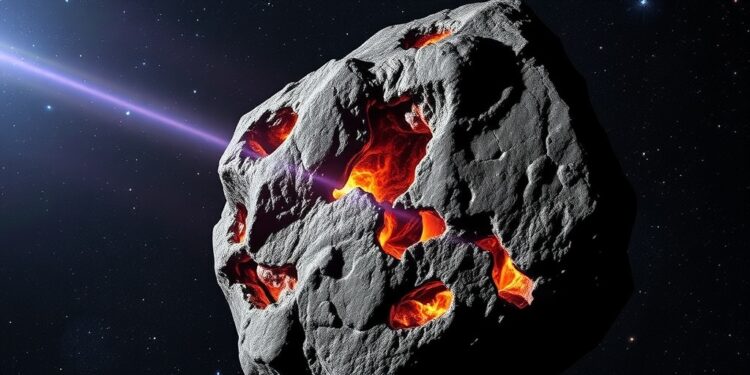An international consortium of researchers has made significant strides in unraveling one of the enduring mysteries of space science: the fate of carbon-rich meteoroids as they traverse the Earth’s atmosphere. This new study, which represents the most comprehensive analysis of meteoroids to date, could have profound implications for our understanding of the origins of life on Earth. By examining close to 8,500 meteoroids and meteorite impacts globally, the research team was able to peer into the processes that dictate which celestial bodies ultimately reach our planet’s surface.
The researchers were drawn from prestigious institutions, including Curtin University’s School of Earth and Planetary Sciences, the International Centre for Radio Astronomy Research (ICRAR), and the Paris Observatory. Their collaborative effort involved meticulous analysis of data garnered from 19 fireball observation networks spanning 39 countries. Such a massive dataset enabled the team to draw compelling conclusions about the nature of meteoroids and the role of environmental filters they encounter on their journey through space.
One major revelation from this research is the role of Earth’s atmosphere and the Sun in acting as colossal filters that hinder the survival of fragile, carbonaceous meteoroids. Historically, scientists have speculated that these weak materials have a low survival rate upon entering the atmosphere, but this study takes that understanding deeper. The new findings indicate that many carbon-rich meteoroids disintegrate due to repeated heating as they orbit close to the Sun, making their arrival on Earth exceedingly rare.
Dr. Hadrien Devillepoix, a co-author from Curtin University’s Space Science and Technology Centre, emphasized the importance of this investigation. He articulated that the study’s findings illustrate that not all meteoroids are destined for atmospheric entry. Some falter long before the atmospheric encounter due to thermal stresses during their solar orbits. The implication of this research calls into question how many potential carbonaceous meteorites may have been lost before they even had a chance to reach Earth.
This has broader implications as carbonaceous meteorites are vital to understanding Earth’s origins, primarily due to their potential to harbor water and organic molecules, crucial ingredients linked to the emergence of life. These findings compel us to reconsider our metrological collections, which currently lack adequate representation of these valuable celestial bodies, thus risking an incomplete understanding of the universe’s early building blocks.
Dr. Patrick Shober from the Paris Observatory articulated the significance of these results as they reshape scientific interpretations of meteorites collected thus far. He noted that the scarcity of carbon-rich meteorites in existing collections offers a distorted view of what exists beyond our planet and what contributed to the emergence of life on Earth. He emphasized that elucidating the filtering processes is essential for reconstructing the history of our solar system and understanding the environmental conditions fostering life.
Furthermore, the study delineates that meteoroids formed through tidal disruptions—events during which asteroids fragment due to close encounters with larger celestial bodies—are particularly delicate. This fragility means that they almost never manage to survive their descent through Earth’s atmosphere. This finding holds significant implications, as it could influence future exploratory missions targeting asteroids and enhance our strategies for assessing impact hazards.
In light of this research, experts in the field assert that understanding the lifecycle of carbonaceous meteoroids can refine our theories regarding how Earth acquired its essential water and organic compounds that were instrumental in the genesis of life. The gap in our existing knowledge begs the question of what other celestial treasures may have been unlawfully filtered out by the forces of nature, forever thwarting our quest to understand our cosmic beginnings.
As the dialogue surrounding the origin of life and the precursors to biological complexity continues to evolve, this research serves as a cornerstone for further investigation. The collaboration among international institutions demonstrates a unified effort to tackle cosmic mysteries, pooling expertise and resources to unveil the hidden narratives behind meteoroids and meteorites venturing into our atmosphere.
With the backing of organizations like the International Centre for Radio Astronomy Research, the research aims to inspire future studies that can explore these themes with renewed vigor. Understanding the nature and fate of carbon-rich meteoroids could not only change how we view meteoritics but may also shed light on the larger questions of existence—questions that linger on the edges of both science and philosophy.
The insights gleaned from this study will undoubtedly inform future scientific missions, refine our approaches to assessing potential asteroid threats, and expand our understanding of the primordial ingredients necessary for life. With each data point gathered and analyzed, researchers move closer to revealing the mysteries of the universe, painting a more detailed picture of how life may have arisen on our planet.
As we decipher the cosmic networks of life’s origin, this new study captures a clear intersection of observational astronomy, planetary science, and fundamental biology. Each finding resonates with the promise of unlocking further knowledge about our history and the celestial events that shaped our planet.
In summary, this groundbreaking research not only illuminates the fate of carbon-rich meteoroids but prompts a reevaluation of the frameworks within which scientists study the genesis of life. As we forge ahead into the depths of space and time, the realization of our celestial heritage becomes ever clearer, framing humanity’s journey in the cosmos as a shared venture into understanding our origins.
Subject of Research:
Understanding the fate of carbon-rich meteoroids in relation to the origins of life.
Article Title:
Perihelion history and atmospheric survival as primary drivers of the Earth’s meteorite record.
News Publication Date:
14-Apr-2025.
Web References:
DOI Link
References:
Pending further specification.
Image Credits:
Pending further specification.
Keywords
Carbon-rich meteoroids, meteorites, origins of life, Earth, atmospheric entry, solar systems, astrobiology, celestial bodies, observational astronomy, planetary science.




